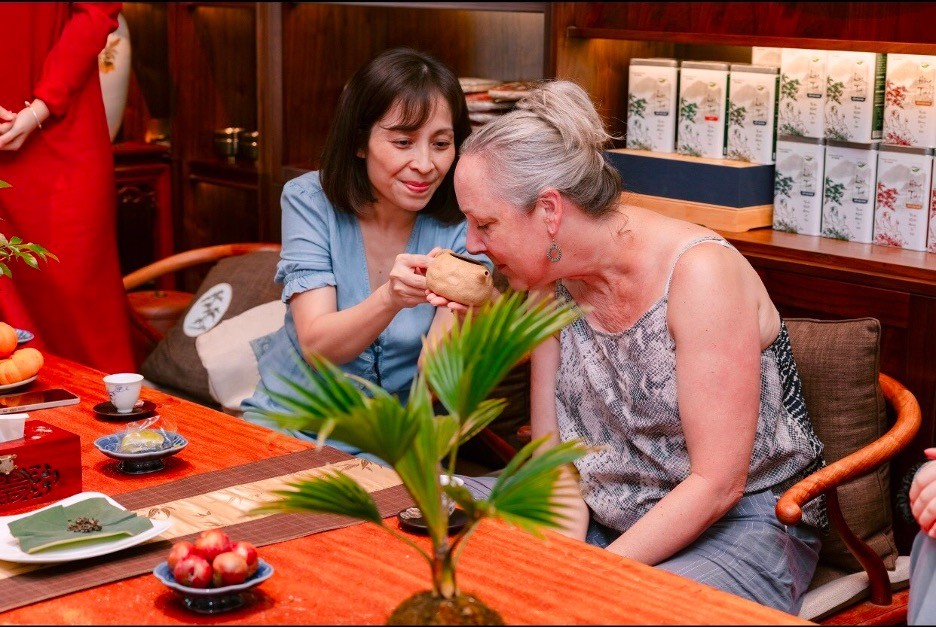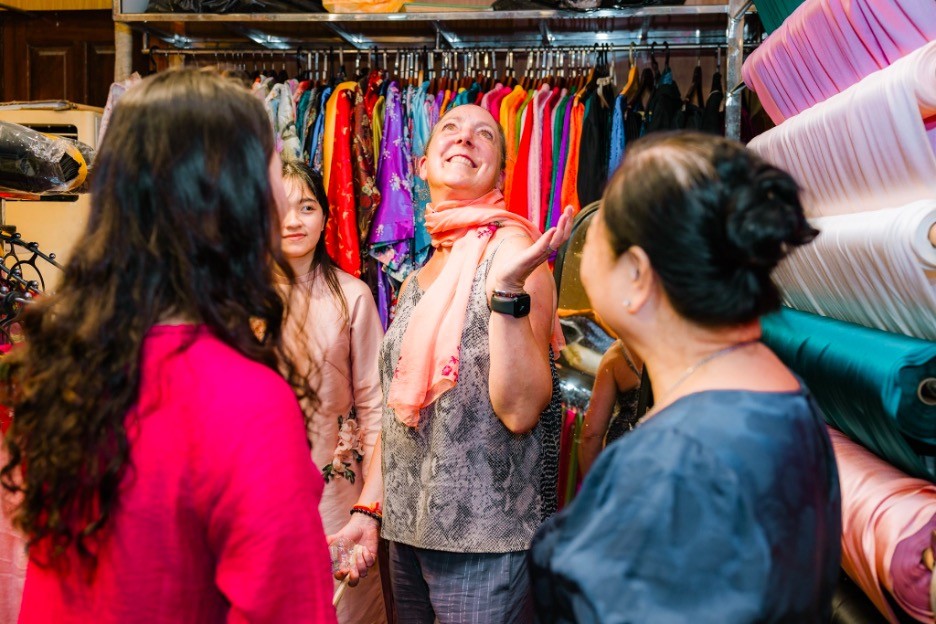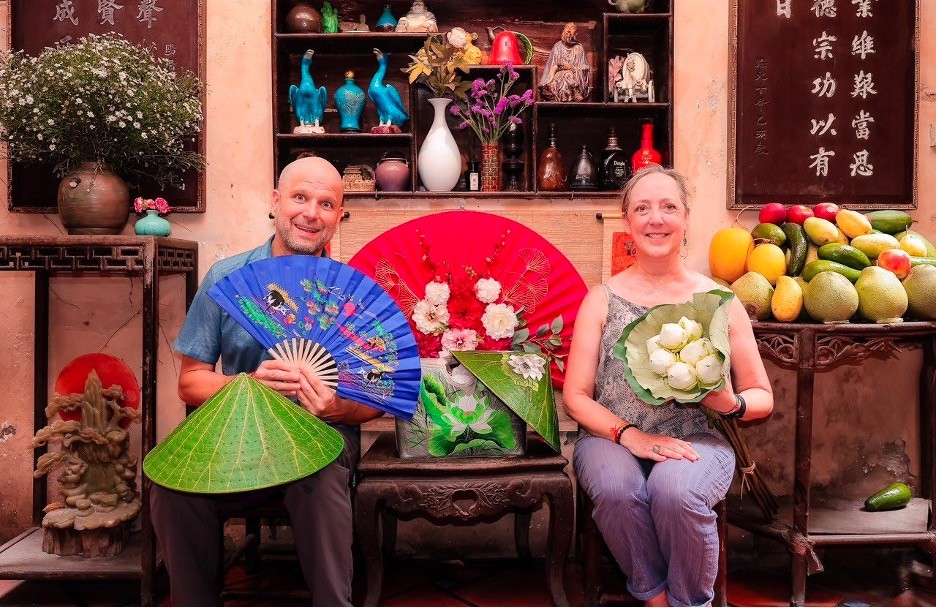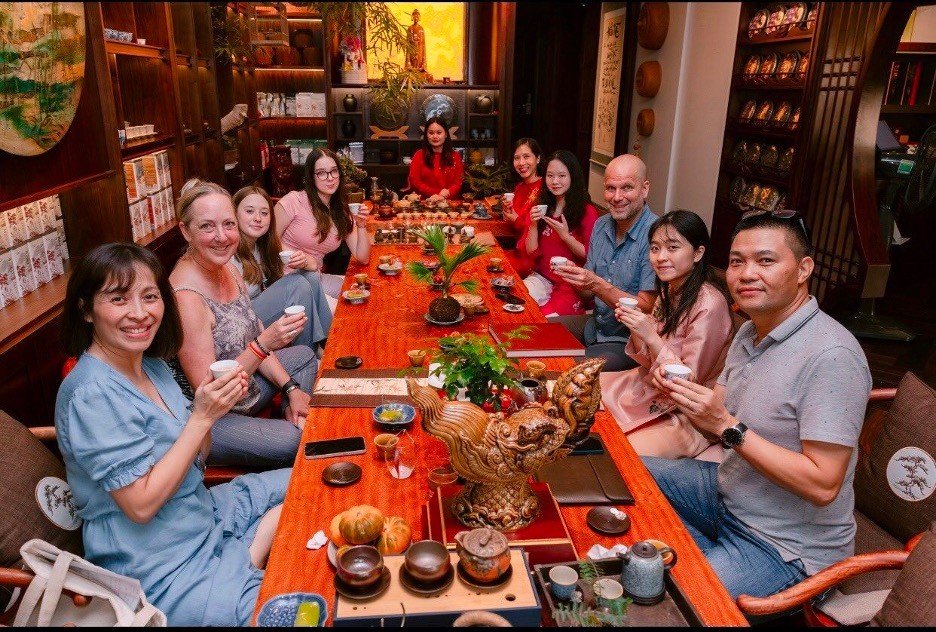
From Alaska to Hanoi: A journey of connection and exploration
There exist profound connections within the soul that are often inexplicable. Although Associate Professor Shannon journeyed through many regions of Vietnam, inspiring countless teachers and students, it is Hanoi that left an indelible impression on his heart, unlike any other place.
Welcoming him on a summer day, we had the privilege of listening to his reflections on the cross-national connections that have profoundly shaped his life.
 |
| Assoc. Prof. Shannon Gramse savors tea at the Bashtea tearoom. (Photo: Tran Duc Quyet) |
Assoc. Prof. Shannon, after five years of immersing yourself in the diverse regions and landmarks of Vietnam, you've arrived again in Hanoi. How has this vibrant city touched your heart and what unique qualities set it apart from the other places you've explored?
Unlike my first visit in 2019, I now see how Hanoi has in many ways the heart of the matter. Things I most admire about Vietnamese culture—community, rootedness, exuberance, grit, generosity—are evident here in abundance. Ho Chi Minh City is my family’s “home base” in Vietnam, and we love it there as well, but I deeply appreciate the sense of history and national pride that Hanoi exudes.
After our day together in Hanoi, I’ve been thinking about culture and cultural exchange, especially the notion that we only really begin to understand our own way of life or own hometown when we share and compare it with others. We’re immersed in culture like fish in water, so it’s easy to take it for granted. But the insights afforded by cross-cultural experiences unfold in two directions, externally, of course, but also internally. I suspect that after researching these landmarks and showing us around, you now see Hanoi differently too.
| Associate Professor Shannon Gramse serves in the Writing Department at the University of Alaska Anchorage (UAA) in Alaska, USA. He has volunteered as an instructor for the House of Wisdom program, part of the Lifelong Learning Institution. Over the past five years, he and his family have significantly contributed to educational and cultural exchange initiatives, impacting thousands of students, educators, and community members throughout the House of Wisdom system in various regions of Vietnam. |
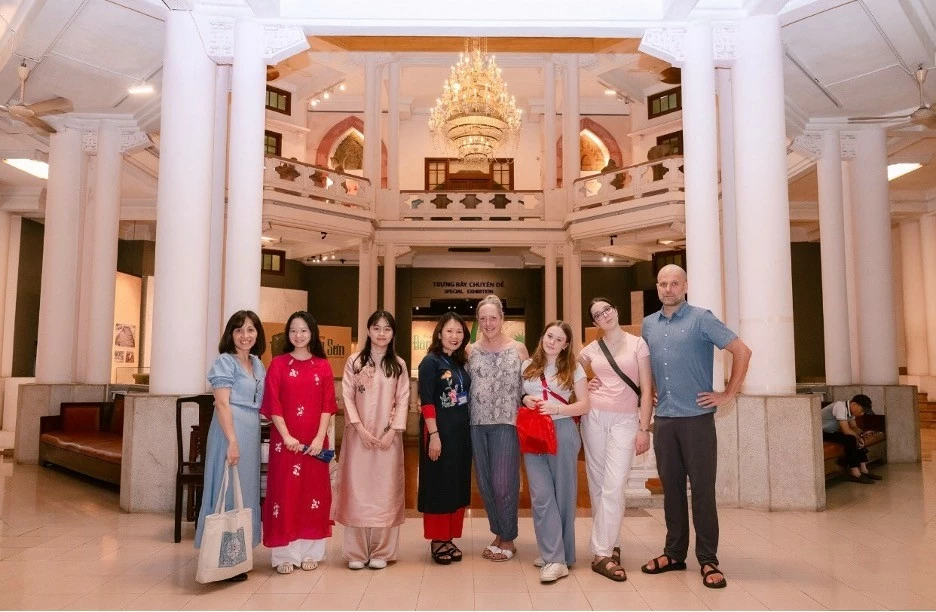 |
| Assoc. Prof Shannon Gramse's family and the two authors of the article (second and third from left) visit the Vietnam National Museum of History for an enriching experience. (Photo: Tran Duc Quyet) |
Alaska and Hanoi offer profoundly different cultural experiences, especially in their culinary traditions. From your recent journey in Hanoi, what stood out to you as the most captivating difference?
Hanoi and Alaska definitely have different culinary traditions. Alaskan seafood is among the best in the world, but our agriculture is limited due to short summers. Most Alaskan food is imported from what we call “The Lower 48”, so it’s the same as other American food, which is a hybrid of culinary traditions from around the world. You can get a decent banh mi or bowl of pho in Anchorage, Alaska, though you’ll pay four times more than in Hanoi. In Vietnam, I love all the tropical fruit and fresh herbs, things we either can’t get in Alaska or are very expensive and at the end of a long supply chain. Alaska has traditional delicacies like smoked salmon, moose steaks, and wild berries, but, in my opinion, they can’t compare with the diversity and refinement of Vietnamese cuisine.
On our recent visit to Hanoi, we ate pho at a place near Hoàn Kiếm Lake that’s been serving the same dish since 1952. We walked down a narrow alley, were greeted by the family working over steaming vats of broth, and then wound our way up narrow stairs to a table in what felt like someone’s private home. The pho was fantastic, but the atmosphere and the pride with which you shared the experience made it all the more special.
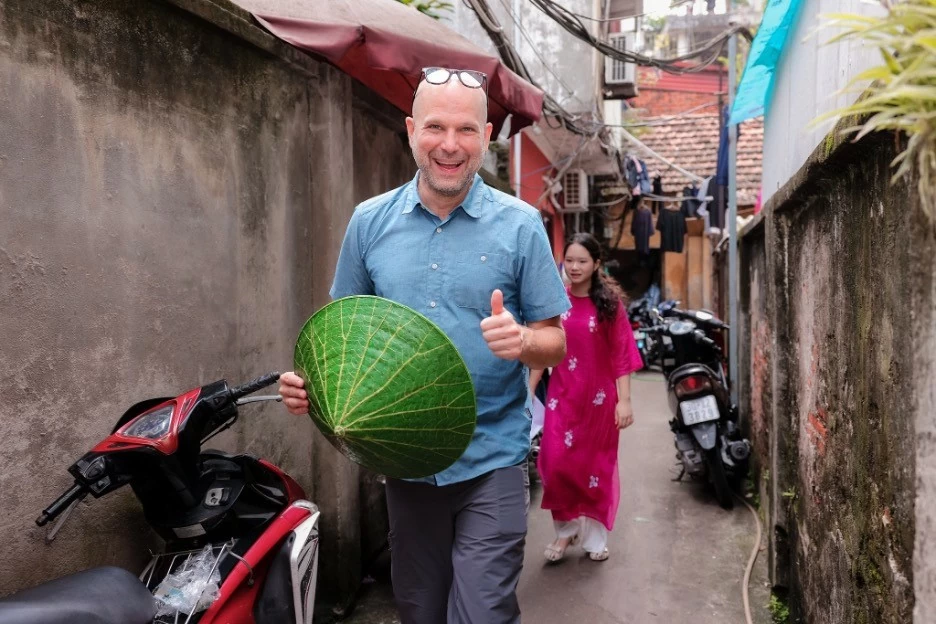 |
| Assoc. Prof. Shannon Gramse enthusiastically carries a conical hat made from fresh lotus leaves. (Photo: Tran Duc Quyet) |
As a scholar of colonialism in both Alaska and Vietnam, your visit to the Vietnam National Museum of History must have been deeply moving. Can you share a moment from the museum that left a lasting impression on you and explain its significance?
I always appreciate learning Vietnamese history from Vietnamese perspectives. My family and I have had to confront realities that American schools and our national discourse simply don’t acknowledge. As you may recall, my wife wept while we walked through the National Museum exhibition dedicated to the American War. On the other hand, maybe because of that war’s outcome, Americans seem more fixated on our countries’ sad shared past than do the Vietnamese people I meet.
In that broader spirit, I’ll mention how fascinating it was to see the prehistoric material in the Vietnam National Museum of History, stone tools and even human teeth from 30,000 or 40,000 years ago that prove Vietnam as a cradle of civilization. There is so much more to your country than colonialism and war. I wish more foreigners realized this.
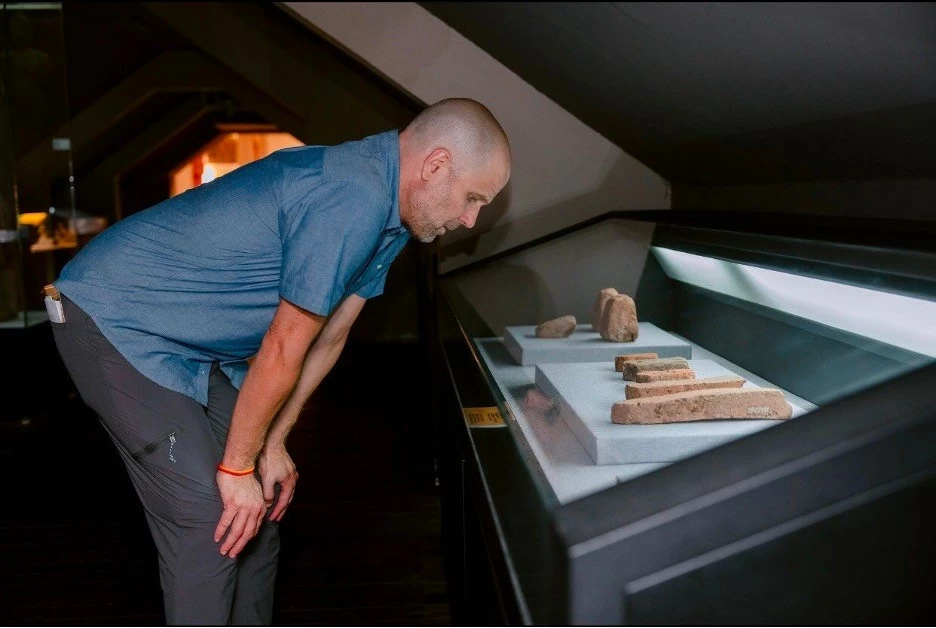 |
| Assoc. Prof. Shannon gazed in admiration at the artifacts from the Funan culture.(Photo: Tran Duc Quyet) |
Your admiration for Hanoi's beauty once inspired you to write a captivating poem about Hoan Kiem Lake and the legend of Le Loi returning the sword to the Turtle God five years ago. As you return to Hanoi for the second time, how have your feelings, love and perspective on the city evolved since your first visit?
After my family and I first visited Hanoi in 2019, I wrote a poem called “Eating Ice Cream beside the Lake of the Restored Sword”. The poem tells the story of Le Loi and Thần Kim Quy and extends this myth to the present day through the real turtles, now on display in Ngoc Son Temple, that died in 1967 and 2016. I’m fascinated by such a mix of national mythology, environmental conservation, and cryptozoology. My poem wonders and hopes that there might be more turtle gods lurking at the bottom of lake waiting to emerge when Vietnam most needs them. The final image depicts a glitzy scene on the lakeshore, people enjoying life and eating ice cream, but only a few looking out across the water for signs of another turtle-in other words, most folks turning their backs on history, which is probably extinct anyway.
Now, five years later, returning to Hoan Kiem Lake on such a passionate, informative tour led by you two young students, I understand my poem’s conclusion as rather naïve, a cynical and ill-informed take on cultural continuity and resilience. Looking back, I feel similarly about several poems I wrote in Vietnam from that time. I still don’t know much, but back then I was truly just a tourist. An interesting thing about writing is the way it creates a record of one’s thoughts and feelings at a particular moment. Revisiting our words at a later date provides insights into the zig zag of personal growth and changing perspectives. Also, since writing forever invites revision, we can always go back and change our ideas accordingly, creating a new time capsule. Thanks to you, I hope to do something like that with my Hoan Kiem poem.
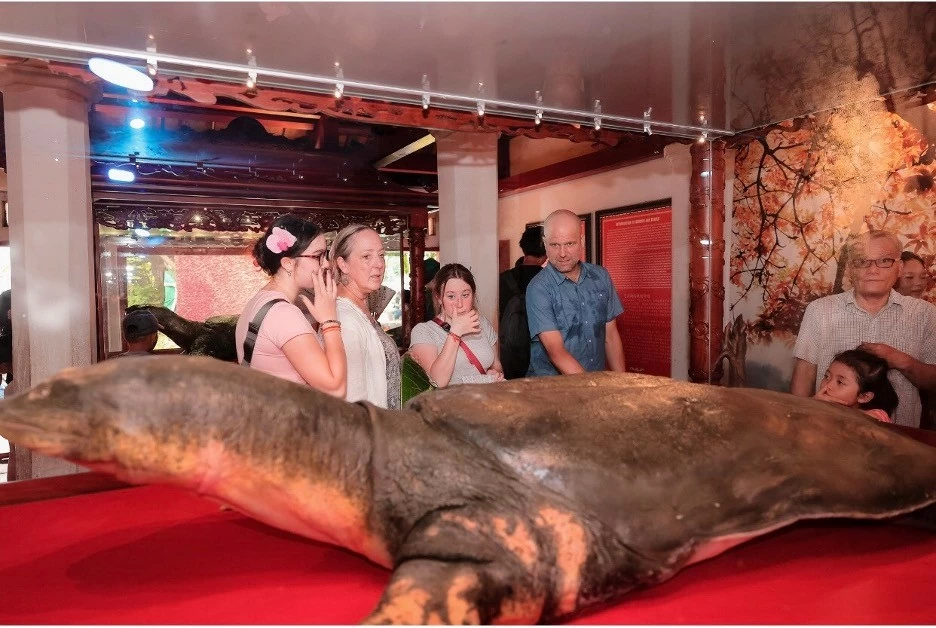 |
| Assoc. Prof. Shannon Gramse, together with his wife Professor Sarah Kirk and their daughters, visited Ngoc Son Temple to see the revered turtle specimen. (Photo: Tran Duc Quyet) |
If you were to encapsulate the essence of Hanoi in three words, what would they be? Please share the reasons behind your choices.
Historic. Vibrant. Multilayered.
“Historic” because Hanoi has more than 1,000 years of history. Walking around, you can feel the antiquity in your bones.
“Vibrant” because Hanoi is so full of life; countless vignettes unfold everywhere in harmonious chaos.
“Multilayered” because Hanoi is so complex. I love the ancient, narrow, bustling streets and then, overlaid above, the shining skyscrapers and modern network of expressways and train tracks.
 |
| Assoc. Prof. Shannon and his wife explored Van Phuc Silk Village. |
***
We presume that the experience in Hanoi has left Associate Professor Shannon with unforgettable impressions. He has extended an invitation to us for a reunion in his homeland—the majestic and awe-inspiring Alaska, at the very northern tip of America. Indeed, cultural experiences serve as bridges that unite people, connecting hearts and minds notwithstanding distances.
We reflected deeply on our fortunate encounter with individuals from across the globe, on a land steeped in the scars and beauty of history, rich with profound cultural and historical memory. This seemingly brief interaction has the potential to inspire an endless journey of exploration and understanding in the years to come.
Such meetings profoundly enrich our understanding of the world and ourselves, fostering a deeper appreciation for the diverse cultures that shape our global community. The promise of a future meeting in Alaska stands as a testament to the enduring bonds formed through these meaningful exchanges, reminding us that the spirit of learning, exploration, and love transcends all geographical boundaries.


